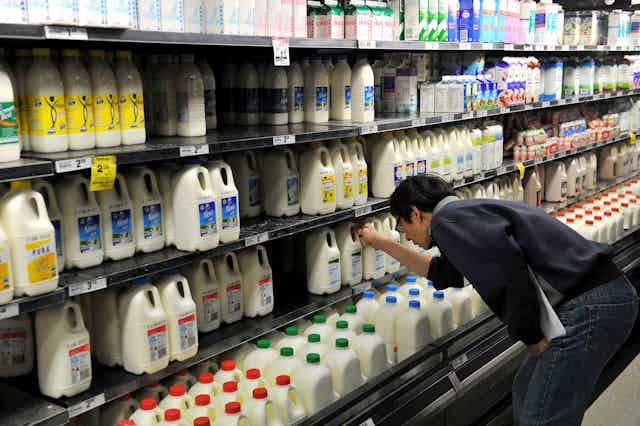A fall in the farm gate price of milk and the pain felt by dairy farmers as a result, has many pointing the finger at supermarkets for discounting the price in the so-called “milk wars.” However the suggested solution of raising the price we pay for milk to pass on more profit to farmers is misguided.
Supermarkets have been driving down the cost of basic goods like milk since 2011. But the actual underlying culprit for the fall in prices has been the global glut of supply relative to demand driving down the world price, with only a partial offset from the decline in the Australian exchange rate.
Others have advocated for a return to the regulation of the 20th century with a domestic price set at a premium, or retailers selling branded milk at a premium and returning a share to dairy farmers. In reality, the likely income gain from increasing prices for domestic milk sales would be small.
Australia’s current industry policy is to let market forces set prices, investment and employment across different sectors and industries, rather than government “picking winners” and subsidising selected industries. Setting prices for the dairy industry, would be a return to the “bad old days” with a risk of a decrease in farm productivity.
Market Context
About 25% of farm milk production goes to fresh milk sales for domestic consumption. In turn, about a half goes to supermarkets where the store brands, sold for a dollar a litre, account for a bit over half of all supermarket sales. Some branded milk sells for nearly double the store brand milk.
If more people switched to buy a more expensive brand of milk, how many would it take to make enough returns to save dairy farmers? At the moment the maximum amount of milk sold for a dollar a litre would represent about 8% of current farm production.
The remaining 75% of farm milk is used to manufacture a range of products, including butter, cheese, skim milk powder and whole milk powder. Roughly half of the butter and cheese is exported, and 70% of the milk powder. Australia imports cheese as well as exports. The Australian dairy industry depends on the world market for much of its production.
Another aspect that determines the returns for dairy farmers is the world price for manufactured dairy products, adjusted for movements in the Australian exchange rate. If supermarkets raised the farm gate price of milk above that which other countries pay for milk products, processors would switch from manufacturing these products to processing milk instead.
By the same argument, if some retailers are paying farmers above the export parity price, competitors will bid milk away from exporters and undercut the high payers to drive prices back to export parity. That is, the export price provides both a floor and a ceiling to the price which supermarkets can negotiate.
Australian dairy product exports represent a small share of world trade of dairy products, and a very much smaller share of world production. While it would be an oversimplification to say Australia doesn’t have a stake in setting the global dairy price, a 10% or 20% increase in Australian exports would require a very small export price reduction.
A return to ‘the bad old days’
Set prices for dairy products, and other agricultural products, were phased out as a part of economic reform in the 1980s and 1990s for a more productive economy and the reasons for this remain valid today.
Setting a price for domestic sales, in this case milk, above the export price leads to a battle between different parties and lobby groups as to what price to set, it may also influence consumers’ decisions as to what they buy and arguably some more than others. It could also shift more resources on farms into the dairy industry, chasing a higher price and away from other types of production (which are set by a global price) such as meat or horticulture.
For those dairy farm households facing poverty as a consequence of the slump in world prices, it is more direct and effective to provide direct household support than to artificially increase the product price for all dairy farmers.

